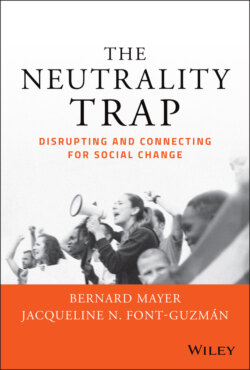Читать книгу The Neutrality Trap - Bernard S. Mayer - Страница 13
Nonviolence and Disruption
ОглавлениеAs may be obvious, nonviolence is one key to sustainable ap‐proaches to systems disruption. Nonviolence as both a philosophy and a strategy has been at the heart of many of the most important and successful social movements in recent history. The anti‐nuclear, civil rights, women's, gay rights, and environmental movements have largely adhered to a commitment to nonviolence. This has been essential to sustaining them and to harnessing the moral power that has been vital to their success.
But we should remember that the power of nonviolence lies not only in its moral consistency and vision but in what lurks behind it. The alternative to taking seriously the grievances expressed by nonviolent protestors is often chaotic and destructive violence. This was true of the movement against British Colonialism led by Mohandas Gandhi, the struggle to end apartheid in South Africa, and the US civil rights movement. We should also remember that in a White supremacist system, people of color are held to a very different standard about violence than White people.
At the opening of the Livonia Trial in 1964, Nelson Mandela discussed why after years of a disciplined commitment to nonviolence, he chose to participate in acts of sabotage against the apartheid regime of South Africa:
“All lawful modes of expressing opposition to this principle had been closed by legislation, and we were placed in a position in which we had either to accept a permanent state of inferiority, or to defy the Government. We chose to defy the Government. We first broke the law in a way which avoided any recourse to violence; when this form was legislated against, and when the Government resorted to a show of force to crush opposition to its policies, only then did we decide to answer violence with violence.”
(Mandela, Statement at the opening of his trial on charges of sabotage, Supreme Court of South Africa, 1964)
Mandela never disavowed this decision, albeit one he was very loath to make. Whether this was the wisest or most effective approach remains an interesting question. The group that engaged in sabotage (Umkhonto—an offshoot of the ANC) was quickly broken up, and these actions led to the long imprisonment of Mandela and his associates. Directly, it did little to disrupt the apartheid system. But 27 years later, Mandela emerged from imprisonment as a widely respected leader who was able to negotiate an end to apartheid and take the critical initial steps to building a new society. His power was in part derived from the widespread recognition that he was perhaps the only one with the credibility to enter into an agreement that would not be immediately rejected or provoke mass outbreaks of violence.
Recognizing that the power of nonviolence lies to some extent in the alternative it provides to a more violent confrontation does not mean that proponents of nonviolence are hypocritical. Effective movements for social change, as noted above, are not pristine or rigidly consistent.
